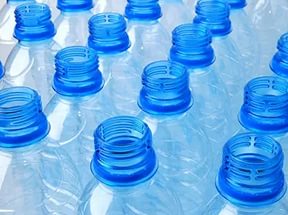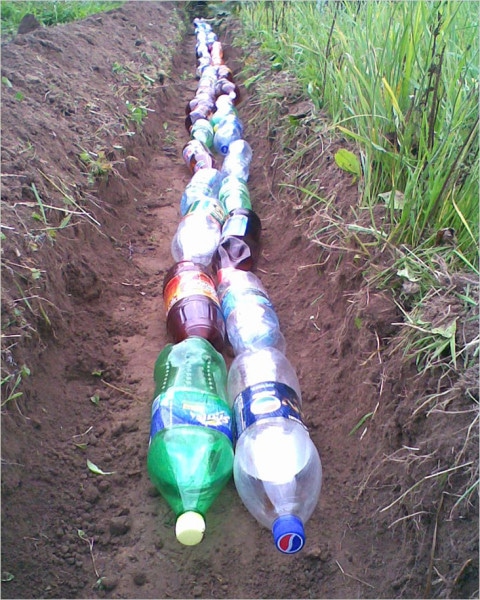The high level of groundwater brings a lot of trouble to the owners of suburban areas, creating serious difficulties in growing most crops. In addition, water gradually destroys the foundations of buildings, and the constant dampness in the cellars does not allow for long-term storage of crops. The drainage system, which can be built from ordinary plastic bottles, will allow you to get rid of the problem. On the one hand, this option will take more time than the implementation of modern drainage structures. On the other hand, it practically does not require financial investments, which is a weighty argument for many site owners. In this article, we will consider how to make drainage from plastic bottles and ensure optimal soil moisture in the backyard.
Plastic containers are convenient to use for arranging drainage due to its availability. Most of the liquid products of the food industry are stored in PET bottles: carbonated water, dairy and sour-milk products, vegetable oil, beer, kvass and much more. If you do not periodically dispose of plastic waste, then dozens and even hundreds of such containers can accumulate on the farm.

Waste from plastic containers
A little about PET packaging
The raw material for the manufacture of plastic bottles is polyethylene terephthalate, a product of the synthesis of ethylene glycol and terephthalic acid. The material was developed and patented back in 1941 and has since been widely used in various areas of human life.
Interesting to know. Initially, polyethylene terephthalate was used in the textile industry. A little later, they began to produce packaging film from it. And only in the 70s of the last century, DuPont for the first time produced a PET bottle to compete with glass containers when bottling drinks.
The main advantage of PET packaging is its weight. If a half-liter glass bottle weighs 350 g, then the weight of a plastic container of the same volume is only 17 g, that is, 20 times less. In addition, polyethylene terephthalate, unlike glass, does not belong to brittle materials, which greatly simplifies the transportation of products.

PET is a lightweight and durable material for storing liquid products.
Benefits of bottled drainage
The advantages of using plastic bottles for drainage include the following points:
- Durability. The service life of PET containers is 50 years.
- Availability. Even if such material is not available in sufficient quantities at home, it can be purchased for little money in the market or in grocery stores.
- Ease of installation. The implementation of the drainage system is carried out without the use of special equipment.
- Security. Plastic bottles in the ground do not adversely affect the soil and the environment.
Note. It is believed that plastic emits harmful substances. However, this process occurs only when the material is strongly heated. Since the container is protected from direct sunlight and open flame underground, you can not worry about its safety.
Drainage from plastic bottles
There are two ways to make drainage from plastic bottles. The first option involves using bottles as a drainage pipe, and the second as a drainage layer.
Option number 1: drainage pipe device
PET drainage pipe is manufactured using the following technology:
- Several drainage holes are made in the bottles.
- Scissors cut off the top and bottom of each container.
- Prepared parts are connected with adhesive tape.
- The finished pipe is wrapped with a geotextile.
Important. Geotextile acts as a filter, protecting drainage holes from silting. In the absence of such protection, the drainage work will very quickly lose its effectiveness.

http://nashsovetik.ru/wp-content/uploads/2015/07/P1030426.jpg
Making a drainage pipe from plastic bottles
Since when cutting a plastic container, it loses its strength, such a pipe cannot be located at great depths. In addition, crushed stone bedding should be provided to protect the structure from deformation.
Option number 2: installation of a drainage layer
A simpler, but no less effective option for using plastic bottles for site drainage is the arrangement of a drainage layer. In this case, the following work is performed:
- A trench is dug to a depth of about 0.5 m.
- At the bottom, PET bottles are placed tightly together in two rows.
- From above, the container is covered with a layer of sand, and then soil.
- Each layer is well compacted.
Note. All bottles must be capped. The air remaining inside will give additional rigidity to the structure and will prevent its deformation under the weight of the soil.

The voids between the bottles allow water to freely leave the territory along the trench
Popular drainage schemes
Drainage arrangements on the site may be different. Most often, two structures are used to protect the territory from waterlogging: ring and fir-tree.
Ring design
The ring scheme is used to protect the foundations of buildings from surface water. So that water after heavy rainfall or melting snow does not accumulate near the house, a trench is dug around the perimeter of the object, in which drainage from bottles is arranged.
The distance from the trench to the building depends on the size of the blind area and, as a rule, is about 1 m. The depth of the trench should not be too large. Firstly, plastic containers under soil pressure can be deformed, and secondly, for the rapid removal of precipitation, drainage should be as close to the surface as possible.
Important. To protect the building from groundwater, drainage is located 30-50 cm below the foundation. For such purposes, a specialized drainage pipe made of PVC or HDPE should be used, which can withstand heavy loads.

Foundation ring drainage
herringbone design
In its form, the design resembles a Christmas tree (hence the name) or a river system with a main channel and several outlets. The number of outlets depends on the area of the drained territory. At the same time, their slope should be directed towards the main highway, which in turn has a slope towards the water collector - a drainage well, ditch or pool.
Such a scheme is ideal for swampy areas, allowing you to drain a large area. Of course, in this case, a large length of the pipeline will be required, but if you make drainage from plastic bottles, the costs will be minimal.
Advice. The trenches in which the drainage system is located can be sprinkled with fertilizers. Thus, before entering the water collector, the water will be saturated with useful substances and will be suitable for fertilizing the garden plot.

Drainage of the territory by means of a Christmas tree drainage structure
The method of arranging drainage from plastic bottles is very popular due to its availability. In many situations, this option will allow you to remove excess water from the surface of the site and make the area more suitable for plant life and construction projects. Nevertheless, it is undesirable to use PET containers for the construction of a deep drainage system designed to protect the site from groundwater. In this case, it is better to seek help from specialists who will develop the optimal layout of the pipeline and install it using modern drainage structures.


















